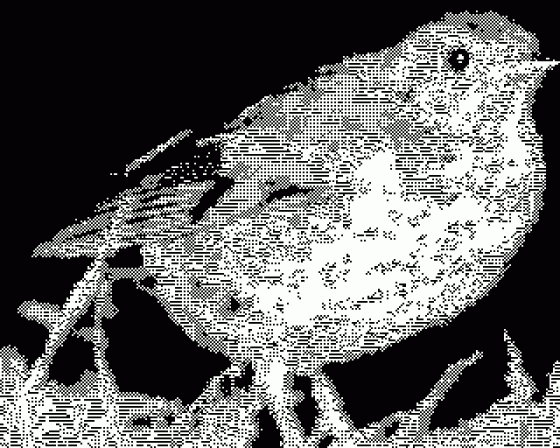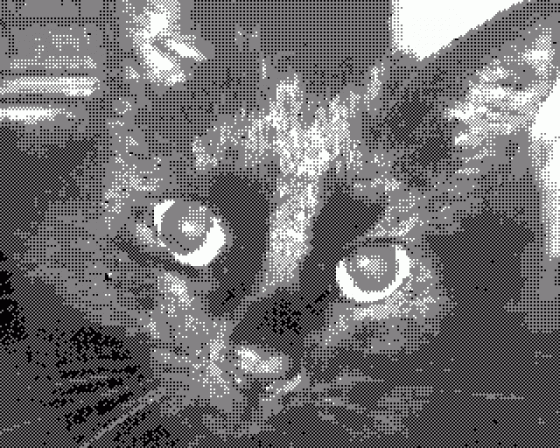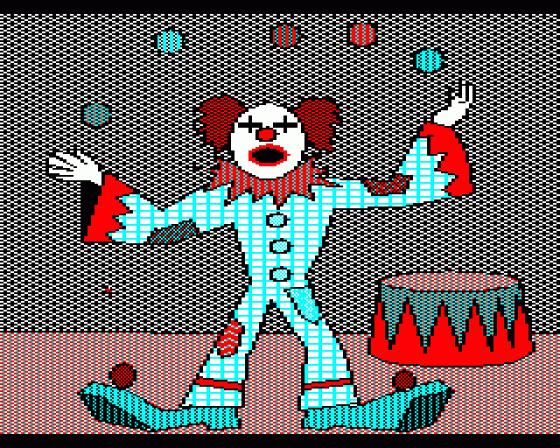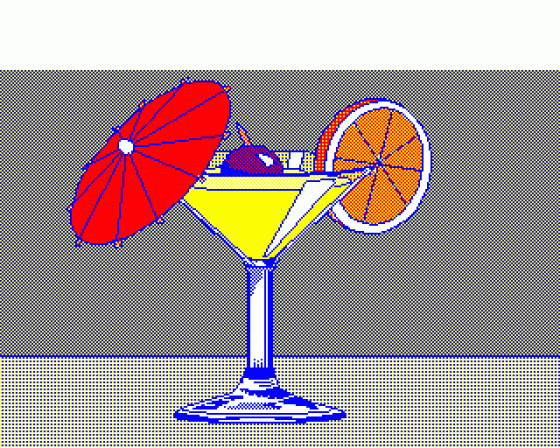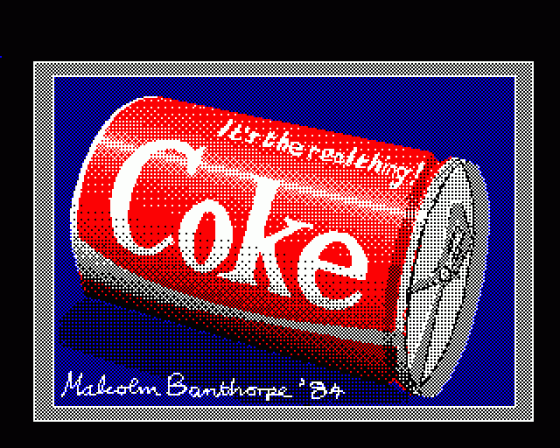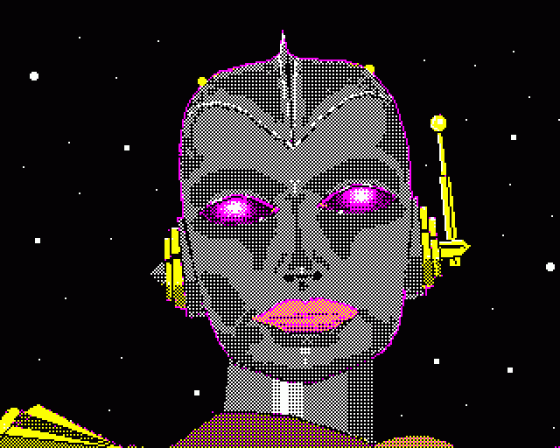
EUG PD
 1st February 2001
1st February 2001
Categories: Review: Software
Author: Dave E
Publisher: Acorn User
Machine: BBC/Electron
Published in EUG #56
Unlike with the PC, where it has now become so easy to manipulate photographs, graphics and images that only a bare minimum of skill is needed, producing a good picture on the BBC or Electron takes lots of time and lots of patience. It also takes either considerable skill at programming or a software package allowing you to draw on screen.
The choice, moreso for Elk users than BBC ones, is rather limited in even acquiring the latter tool. If you're very lucky, you'll pick up a boxed and complete copy of Amx Art and a nice analogue mouse. But more likely, you'll find a copied disc in an old box acquired elsewhere, have no instructions for the program that's on it and find the whole process too daunting to begin. Either that, or you'll be faced with a package which only accepts keyboard input such as EUG's own Diagram (EUG #15), Impact's The Art Studio or - horror of horrors! - the Sketch program on the Introductory Cassette!
Even if you persevere, you'll then find the machines simply aren't powerful enough to provide the features we've come to expect. There certainly won't be an Undo facility - make a mistake with the Fill command and you'll have to painstakingly reconstruct your original. And magnifying particular areas of screen? A few pixels at most if you're lucky!
Conversely, it's this exorbitant amount of hassle which can provoke a quite intriguing amount of delight if a very impressive picture appears on your monitor while it's connected to a Beeb. Look no further than Electron User and EUG reviews and letters that praise professional loading (or opening) screens for proof. It's the "How did he do that?!" factor that the 8 bit pictures provoke - and that the PC never will - that ensures they will be popular for quite a few years yet.
There are more pictures out there (sometimes incorrectly labelled as "Clipart"!) than you might imagine, safely stowed in the 8 Bit Software archives. Recently a batch arrived at EUG HQ and it would not be an exaggeration to call some of them unbelievably fantastic. Especially when you put them into the context described above. But they are as interesting from a historical point of view, in the same way that comparing today's computing magazines with those of ten years ago yields much reminiscing and merriment.
This review gives the lowdown on just nine of the discs available for download at www.8bs.com. Running through it, unfortunately is a lack of reliable copyright information. Many pictures crop up on different discs (snatched from the official ones) and almost all are 'unsigned'; their origins as big a mystery as their artists.
The biggest offenders 'snatch' from the Acorn User Gallery range of discs. The Acorn User magazine thought a lot more of the "Clipart Scene" than its contemporaries; it published at least two full DFS discs of images in its lifetime, as well as showcasing a new picture each issue.
Virtually all the pictures gracing them are assured to be colourful and exciting. The 8BS library (and EUG) can supply the Gallery discs #1 and #2. There may have been more and it may be the case that images from subsequent Gallery discs were 'snatched' onto the discs reviewed below.
In the main, these other discs are a gamble. Some are dire, some mix crud with crowd-pleasers and gems like the Joseph Lavery Collection stand head and shoulders above even Acorn User. But this is the Public Domain world in general, isn't it?
Anyway, having established that we "Wow!" only if we appreciate the amount of time the artist must have worked to bring the picture to our Beeb screen, discs TYB-10, TYB-18, TYB-19 and TYB-21 demonstrate the opposite effect. Respectively, these discs are archived as piccies of "Popstars", "The World", "Space" and "The Tower Of London". They are digitised pictures grabbed from a video tape with hardware known as a Digitiser.
This is an area where the PC triumphs over many rival computers. Even 16 bit computers such as the Amiga 500 could never 'grab' pictures from external sources with the requisite degree of quality. On 8 bit, the results really are appalling, akin to watching a still picture on your TV without an aereal connected. Why the BBC Digitiser was once a revolution is understandable but just one digitised picture incorporated in a slideshow inevitably shows not only the dated nature of the machine but also that the 'artist' took no time in presenting something original. (Even Acorn User Gallery discs suffer from this drawback!) To this end, a slideshow of them is out of the question.
Coming off only fractionally better is TYB-41-1, a slideshow of pictures digitised from the Archimedes. These have been ported down to Mode 0 on the BBC so they are of a reasonably high quality, albeit in black and white, but again fail to "Wow!" After all, quite apart from the lack of time it took their author to produce them (apart from connecting up the two machines), you glean the perception that they would be spectacular on an Archimedes. So why look at them on a Beeb?
TYB-11 mixes digitised pictures with both freehand and Mandelbrot And Julia designs. MAJ was once a professional software package (It's now PD!) for designing crazy kaliedoscope-style designs. Output from it, when you can't manipulate the image, rather defeats the purpose so waiting for five images in turn to load (slowly!) after five digitised pics (as slowly!) have annoyed you is frustrating. Fortunately, there are six fair freehand drawings to help quell the despair...
Before continuing, note that the slow loading always comes about because pictures are usually stored on disc in a compressed format. If they aren't, they appear almost immediately but take up lots of disc space. If they are, then the disc contains a lot more pictures but they take considerably longer to be decompressed: usually writing to the screen a line at a time. (You tend to be able to estimate the quality of such a picture from only a few lines. If it looks good, the wait feels short. If not, you'll be reaching for ESCAPE!)
Although TYB-08 gets off to a bad start by presenting AU's "Thomas The Tank Engine" picture (which you find on hundreds of discs and which has even appeared in EUG!), it continues with a nice range of compressed freehand images from 'Guido Designs' including Garfield, Woofer, Judge Dredd, The Iron Man and Daredevil. The quality of the designs isn't too high, and they don't make full use of the screen, but most are colourful and perky - and definitely worth a peek!
Of the final two in the 8BS pile though, there are full-screen images aplenty. The loader program of TAU-11 required a small alteration but, once it was waiting for a keypress before flicking onto the next image, caused much amazement. Designs signed by P. Bailey include a "Lowry" painting, Japanese art and Spiderman, all rendered exquisitely. Another ten images of everything from a map of Xor level 7 to a sensational comic book plane crash are prickled just slightly by the odd MAJ inclusion. But you will "Wow!" All the images are crafted with extreme care.
Finally, we come to the King of the PD picture: Mr Joseph Lavery. How he did it, we'll never know - but his disc The Joseph Lavery Collection (aka TBI-155) has to be seen to be believed. Not a digitised or MAJ pic in sight, Lavery has plotted pixels over fourteen successive Mode 1 screens that defies any budding Picasso. Reality and fantasy blur and the slideshow throws everything at you from a mystical wizard surrounded by swirling "Raiders Of The Lost Ark"-type spirits to the forlorn girl holding a baby cat. Amx Art couldn't get itself a better advert! This is a must see disc.
Hopefully having stimulated some interest, in closing this review, note both that this very EUG includes a selection of pictures and, to couple Joseph Lavery's disc with a quicker-loading menu system, it has been provisionally recompiled, onto both ADFS and DFS, for any EUG reader who wants to order a copy. (Also, look out for a number of extra images not present on his original disc, which have been unearthed and will appear on EUGs #57 and #58.) All the above discs are available free to download from 8BS and four are worth a few moments of everybody's time. Hate to think of how much work went into them though!












